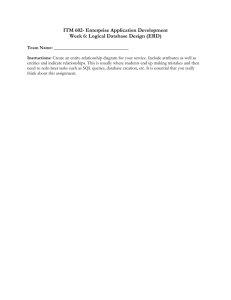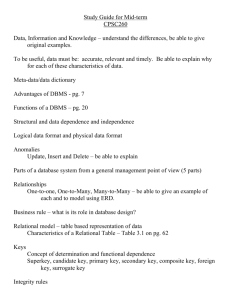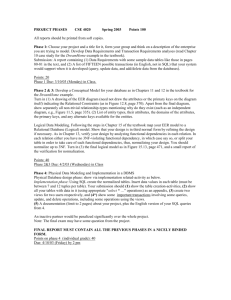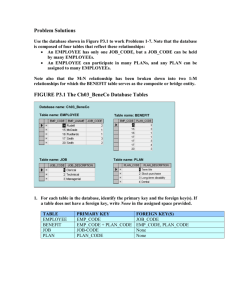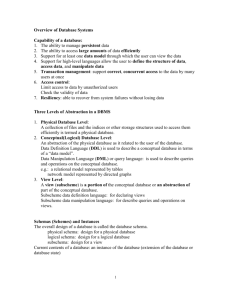Project - Cedarville University
advertisement
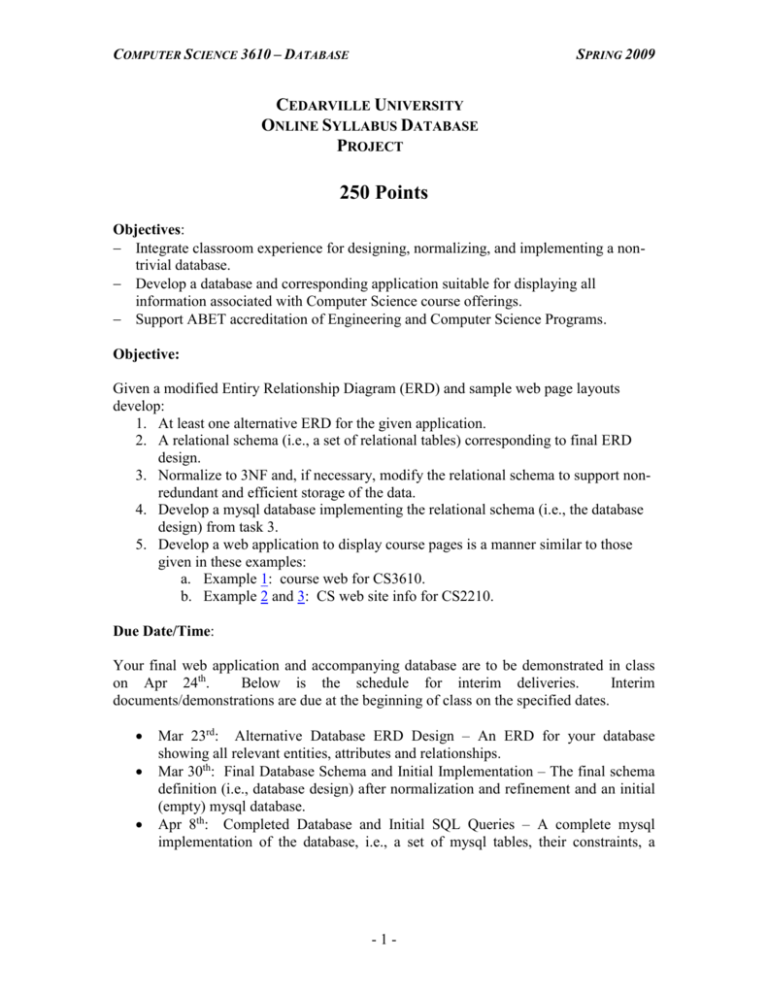
COMPUTER SCIENCE 3610 – DATABASE SPRING 2009 CEDARVILLE UNIVERSITY ONLINE SYLLABUS DATABASE PROJECT 250 Points Objectives: Integrate classroom experience for designing, normalizing, and implementing a nontrivial database. Develop a database and corresponding application suitable for displaying all information associated with Computer Science course offerings. Support ABET accreditation of Engineering and Computer Science Programs. Objective: Given a modified Entiry Relationship Diagram (ERD) and sample web page layouts develop: 1. At least one alternative ERD for the given application. 2. A relational schema (i.e., a set of relational tables) corresponding to final ERD design. 3. Normalize to 3NF and, if necessary, modify the relational schema to support nonredundant and efficient storage of the data. 4. Develop a mysql database implementing the relational schema (i.e., the database design) from task 3. 5. Develop a web application to display course pages is a manner similar to those given in these examples: a. Example 1: course web for CS3610. b. Example 2 and 3: CS web site info for CS2210. Due Date/Time: Your final web application and accompanying database are to be demonstrated in class on Apr 24th. Below is the schedule for interim deliveries. Interim documents/demonstrations are due at the beginning of class on the specified dates. Mar 23rd: Alternative Database ERD Design – An ERD for your database showing all relevant entities, attributes and relationships. Mar 30th: Final Database Schema and Initial Implementation – The final schema definition (i.e., database design) after normalization and refinement and an initial (empty) mysql database. Apr 8th: Completed Database and Initial SQL Queries – A complete mysql implementation of the database, i.e., a set of mysql tables, their constraints, a -1- COMPUTER SCIENCE 3610 – DATABASE SPRING 2009 notional set of data to populate the tables for testing, and a partial set of SQL queries to retrieve static1 data for the web pages. Apr 17th: Completed SQL Queries and Initial Web Application – A final set of SQL queries for retrieving course instance1 data and web pages displaying static data. Apr 24th: Complete Web Application – A web application displaying course information for both static and instance data. Other Details: 1. The project will be completed in two teams of five students. Each team must include at least two students who have completed or are currently in CS4220, Web Applications. 2. Each team will be assigned one database for development, modification, population and testing. The databases will be hosted on john.cedarville.edu with names DBProject2009#, where # is between 1 and 2 (one for each team). 3. Alternative ERDs must be developed electronically (e.g. using Microsoft Word, or some other application which allows for diagramming such as dia). Diagrams must be submitted as both hard-copy and electronic documents (hand drawn documents will not be accepted). Diagrams must be accompanied with at least one page of comments indicating the design rationale for modifications to the original ERD design. 4. Relational schemas will be implemented in mysql. Each table should contain a numeric primary key, unless otherwise justified in comments per item 3 above. 5. Web applications may be written using HTML, php, Java, JavaScript, etc. as most suitably determined by the team. The application must be compatible with both the Internet Explorer and Firefox browsers. 6. Test data for each of the entities in the original schema structure will be provided by the instructor. Some relationship data may be provided. It will be the teams’ responsibility to modify the test data, if necessary, to populate their own tables. Grading: Points for the project are distributed as follows: Alternative ERD Design: 6% (15 points). Final Relational Schema: 10% (25 points). Initial Database Implementation: 10% (25 points). Final Database Implementation: 20% (50 points). SQL Queries to Retrieve Static Data: 6% (15 points). SQL Queries to Retrieve Instance Data: 8% (20 points). Initial Web Application: 10% (25 points). Final Web Application: 30% (75 points). 1 Static data is that information associated with the entities Courses, Professors, Policies, Objectives, and Assignment Types. Instance data is that associated with Office Hours and Course Offerings (and its related entities Schedules, Lectures, Assignments, Textbooks, Links, and Software). -2- COMPUTER SCIENCE 3610 – DATABASE SPRING 2009 Notional Database ERD2: Policies Objectives id, title, text, link id, title, text, level Degrees Office Hours id, year, school, degree id, day, time, duration Bios id, bioText, researchText, webPageLink have have have have pre pre-req post direct Courses Professors 3 id , title, description, hours, objective text, terms hold id, title, fname, lname, phone, email, office, appt, rank, dept, pic teach implement teach Course Offerings id, term, year Schedules id, days, time, place, name have organize provide provide use organize Software Links Textbooks Lectures id, title, description, link id, title, description, link id, isbn, title, edition, year, author, required id, topic Assignment Type id, name Assignments of 2 id, name, value, link, description The standard ERD in our text has been modified in this diagram to save space and reduce clutter. Attributes are listed in the lower portion of the corresponding entity or relationship and keys are bolded. 3 Use course designator for id value rather than numeric key. -3-
